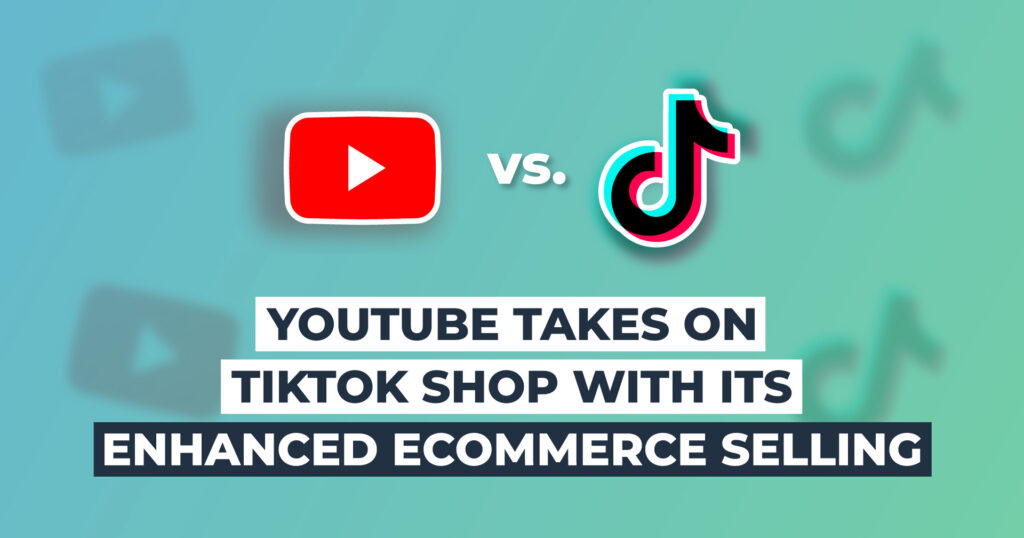With TikTok Shop taking more aggressive steps to win buyer dollars, YouTube Shopping is responding by expanding its partnership with Shopify. This expansion means that all eligible Shopify Plus and Shopify Advanced merchants in the US can now sign up for the YouTube Shopping Affiliate Program, which will allow Youtube content creators to access 1,000s of new brands for tagging and pinning vs. the 100’s they presently have access to.
Benefits of the Expansion
This is a win-win-win for YouTube content creators, YouTube users, and ecommerce brands:
Content creators now have another channel to earn money through their videos vis-à-vis promoting a wider range of brands while also providing a richer experience for their users (helping their audiences find new products). This creates the possibility of taking on more endorsements and expanding their online reach/user count.
YouTube users can now engage on a deeper level with the creators they follow and trust, finding recommendations that are right up their alley.
Ecommerce brands can reach customers through targeted marketing by partnering with creators related to their brand values and/or creators that reach desired target audiences.
Photo Credit: YouTube
Why is this Happening?
Well, money and competition. TikTok is newer to the online shopping game, but they’ve come out the gate in full force by quickly onboarding new merchants—500,000 in 2023 in the US to start. YouTube is no slouch by comparison though. In fact, the company has been ramping up its ecommerce efforts despite a general industry slowdown in digital advertising.
The strategy has been met with positive results thus far, and this is only the beginning given YT’s audience. In 2023, YouTube announced that users were watching over 30 billion hours of shopping-related videos on their platform, bolstering a 25% increase in watch time for videos that help people shop for products.
Undeterred, TikTok is challenging this growth with the assertion that they intend to grow their own ecommerce sales to $17.5 billion in the US this year. Is that possible? Which platform is primed for a better showing? How do the platforms differ? And if you’re an ecommerce brand deciding where to spend your advertising and user engagement dollars, where should you go? Let’s dive deeper into TikTok’s selling strategies vs. YouTube’s.
What is TikTok Shop?
TikTok Shop is a personalized and fully integrated ecommerce channel where sellers can connect with creators and communities to foster a rewarding shopping experience. The China-based social media platform aims to enhance ecommerce selling possibilities for brands of all varieties by utilizing their unique “TikTok discovery engine”, which allows content creators to showcase their products directly on the app in four key ways.
1.) Live Shopping – where you promote, sell, and engage with TikTok audiences in real time
2.) Shoppable Videos – pre-created videos with products people can buy “one tap away”
3.) Shopping Page – a brand’s personal product catalog within their own in-app shop
4.) Shop Tab – a centralized TikTok marketplace where brands display their products
Some of the highlights of using TikTok Shop include:
1.) Live Shopping – The integrated in-app checkout feature that allows the discovery and purchase process to take place, thus streamlining the buyer journey and shortening the purchase funnel.
2.) The ability to harness TikTok Shop Ads, which offers retailers a variety of promotional tools and marketing campaign options.
3.) A chance to discover, connect, and collaborate with creators in TikTok’s Affiliate program.
3.) A range of integrations and solutions included in the TikTok App Store, including the ability to manage all aspects of your sales process.
What’s Next
TikTok wants to harness the power of its global 1 billion daily users and 50 million daily users in the US. Those are the numbers as of May 2024. Equally impressive, right now 18.68% of Americans with mobile internet log in to TikTok every day.
As of January 2024, the US is actually the country with “the largest TikTok audience by far, with almost 150 million users engaging with the popular social video platform” – Matthew Woodward (searchlogistics.com). Additionally, looking at it in terms of regular vs. continuous engagement, “37.36% of US mobile internet users access TikTok at least once a month”.
With that in mind, it’s no wonder that YouTube wants to up its game. Right now they have more than double the engagement of TikTok (YT being the second most-used platform and TikTok in fourth place). However, the name of the game in any area of the market is evolve. Ecommerce selling is a huge part of that, hence YouTube’s plans to evolve its ecommerce selling features to keep its competitive edge over TikTok.
Photo Credit: Search Logistics
What is YouTube Shopping?
The premise of YouTube Shopping is simple. Users can browse and buy products that creators feature in their content. There are six main ways that users can connect with the products that creators endorse.
1.) Products in Description
Creators can list items for sale in their content descriptions. Buyers can then click on desired items and be redirected to either the product/brand’s official store or the product details page before visiting the retailer. Product detail pages may include:
- Images
- Descriptions
- Product Ratings
- Pricing from assorted retailers
- Save and share options
- Related videos and products
Photo Credit: YouTube
2.) Product Shelves
Creators may have a product shelf appear below or next to their videos on mobile devices so viewers can preview items featured in that video. Product shelves may also appear on mobile devices in the search results, watch feed, or home feed. The shelf lists the products the creator has tagged and their prices.
If any item is selected with a TAP while already on a video page, users will either get a preview of the product while still on YouTube or, if a preview is not available, users are redirected to the retailer’s store. If users TAP the product in their search results, watch feed, or home feed they’re taken to the watch page for the specific video the products are tagged/pinned in, where there are details about the product in the creator’s engagement panel.
3.) Content (Long-form Video, Short Video, or Live Stream)
Eligible videos can display product advertisements while content is playing. Viewers can browse the product features while the videos continue and if they wish to learn more they can click buy or learn more, or can click the shopping button or shopping bag icon. When one of said options is selected, a list of products that the creator has tagged/pinned in their videos will appear along with buying links. Content creators also have the ability to pin products during live streams for further visibility.
4.) YouTube Channel Store
A channel’s store tab shows all products sold by that channel’s creators. Store tabs are easy to find; they are on each eligible channel’s homepage.
Photo Credit: TechCrunch
5.) Store Description Links
If a content creator wishes, he or she can include a link to their personal channel store in their video’s description. By selecting the link, viewers can preview the creator’s items that are directly for sale on YouTube while the video they are watching continues to play. Viewers can then click the link/item again to visit the channel’s official store.
6.) Automatic Options
Related Generated Product Sections
YouTube may generate a product section in the watch feed related to what you are currently watching. This feature is not available on all devices or in all countries. Devices that may display automatically generated product sections in the YouTube app include Androids and iPhones. Countries that offer this include the US, IN, BR, AU, CA, PH, and MY.
Intuitive Generated Product Sections
YouTube may generate a product section in a user’s home feed that relates to videos they’ve watched previously. This feature is not available on all devices or in all countries. Devices that may promote these generated product sections in the YouTube app include Androids and iPhones. Countries that offer this include the US, IN, or BR.
Generated Suggestions
If someone specifically searches for a product on YouTube, they may be prompted with an option to browse and shop the product. Once clicked on, viewers are redirected to the product details page to view more info. Devices that may include these generated suggestions in the YouTube app include Androids and iPhones. Countries that offer this include the US, IN, and BR.
YouTube’s New Features
“We know that people come to YouTube every day to connect with the things and creators they love, so we hope these new YouTube Shopping features make that journey even easier for creators and viewers.”
– Aditya Dhanrajani, Director of Product Management, YouTube Shopping
In order to increase engagement and ecommerce ease, YouTube recently announced the launch of new Shopping features that will allow content creators to make their own shoppable collections, better plan their videos that incorporate shopping content, and rapidly monetize older videos with shopping potential. Let’s look more closely at these awesome updates.
Shopping Collections
This new feature gives creators the chance to curate their favorite products from assorted brands in one easy place for their users/followers to browse. The curated collections can be grouped based on theme or category (for example: cute clutches for a night out or must-have tech for travel). These collections will be housed in a creator’s product list, Store tab, and video description area. Once this new feature launches, it will be as easy for viewers to use as it will for creators to use. The latter can make their “Collections” on the YouTube Studio app directly from their phone. (***Note – this will only be on mobile devices for now, but YouTube plans to launch the feature on desktops soon.)
Photo Credit: YouTube Blog
Exclusive Promos and Offers in YouTube’s Affiliate Hub
The new Affiliate Hub directly in the YouTube app will allow creators to find the latest list of Shopping partners, competitive commission rates, and promo codes available. Additionally, the Affiliate Hub is a place where creators can even request samples from ecommerce brands. The goal of the Affiliate Hub is to make it as simple as possible for YT content creators to plan and execute shoppable videos.
Photo Credit: YouTube Blog
Tag Products Across Multiple Videos at Once
Last year YouTube launched the ability for affiliate creators to tag products across their videos in bulk if they have those products included in their video descriptions. That feature is now being further expanded upon so all creators can tag their products across their video libraries, no matter how extensive, so they can earn revenue from new AND old content that still gets a lot of traffic.
Connecting the Fourthwall Shop
Something ShipMonk, a leading 3PL, appreciates is the importance of integrations. We offer 100+ integrations so that the ecommerce brands we work with have the optimal selling experience. Supporting a similar view on making selling easy, YouTube is adding Fourthwall to their growing list of integrated platforms. Fourthwall makes it easy for brands to choose from hundreds of retail-quality products that their designs can be uploaded to and they can sell. This is just one example of an integration YouTube offers to brands to simplify how creators create and manage their stories directly in YouTube Studio.
Photo Credit: Fourthwall Shop
The New Chrome Extension
YouTube is also unveiling a new Chrome extension so creators in the US who are part of the affiliate program can save products while browsing a brand or retailer’s site. That way they can quickly and easily refer back to them when they’re ready to tag the products/brands in a video.
YouTube Shopping vs. TikTok Shop
YouTube’s new updates will definitely allow creators and brands to increase their earnings while fostering a more fun and simple shopping environment for content watchers. As noted though, TikTok is bringing it really hard.
Who will win 2024 and the years to come and how will they do it? Ease of use is the name of the game on the creator and the buyer side of the ecommerce equation at the end of the day. So YouTube’s decision to launch all the new features we mentioned above will make them more competitive with TikTok Shop where everything has already been structured for quick and simple creation and purchase. In terms of other advantages vs. disadvantages the platforms are dealing with, just have a look:
Audience Size
YouTube, as of the beginning of 2024, had 2.49 billion users, and impressively has grown that from 2 billion users in 2019.
TikTok, meanwhile, has only 1 billion monthly active users worldwide.
Audience Range
YouTube limits the “eligible” use of its platform to people 13 and above. Of course people under the age of 13 watch YouTube, but because of the fixed standard, advertising options and content creator options are limited, and thus the teen, preteen, and kid aspects of advertising are limited. Plus, there is no corresponding data for younger audiences who may be watching on YouTube, and data is incredibly important when planning your brand’s marketing approach, or any aspect of your ecommerce business.
TikTok, on the other hand, thrives in the preteen and teen age range. All those amateur dance videos aren’t going to make themselves. Actually, according to a study done in 2024, TikTok’s active users are fairly evenly distributed across the four major target shopping audiences.
Photo Credit: Search Logistics
Purchasing
YouTube has created abundant ways for creators to feature shoppable content and users to discover, click on, learn more about, and purchase that content. However, wherever users do end up discovering those products/brands, they must be redirected off from YouTube to a retailer to make a purchase. And YouTube does not claim responsibility for purchases made through retailers.
TikTok created its shopping model so that users can instantly click on and complete purchases right there within the TikTok app.
Partnerships
YouTube’s new partnership with Shopify is major. At a glance, as of 2024 Shopify has an average 2.1 million active daily users and works with 5.23 million online stores. In addition, Shopify makes up over $444 billion of the world’s current economic activities and “has registered a revenue of $3.86 billion in the first two quarters of 2024”. So Shopify making its Shopify Plus and Shopify Advanced merchants in the US eligible to sign up for the YouTube Shopping Affiliate Program means so much potential revenue on the creator and brand side.
TikTok is TikTok. Take ‘em or leave ‘em.
Photo Credit: PYMNTS.com
The Ecommerce Evolution
If you’re an ecommerce brand looking to expand your audience and engage with potential buyers, YouTube and TikTok can both be great places to make your mark. It comes down to what you value in terms of the types of creators you work with, the kinds of content you want to create and/or be involved with, how you want people to discover and buy from your brand, and what you sell.
With peak season coming sooner rather than later, now may be the perfect time to plan for some compelling marketing content for Q4. So browse YouTube and TikTok today for inspiration, and whatever media platform you decide to advertise on, make sure you have a strong and steady 3PL order fulfillment partner to get those products out the door quickly and accurately when they start selling.





